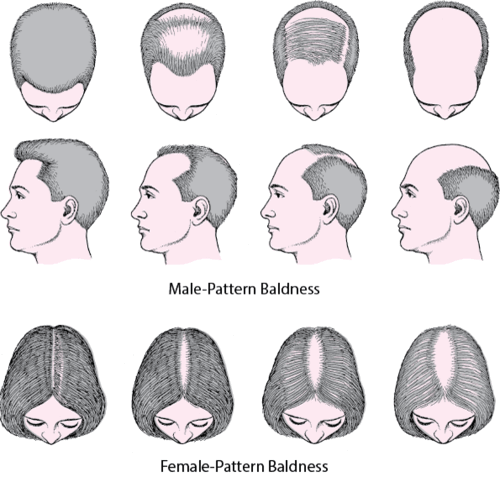The clinical onset of baldness in both men and women is generally around the age of 30 to 40 years. A strong family history is one of the best indicators of male pattern baldness or androgenic alopecia, which is the most common cause of hair loss. Male pattern baldness may begin in the teen years, and becomes more common with increasing age. It is known that the male hormone, testosterone, gets converted to another male hormone, 5-dihydroxytestosterone (5-DHT), in the hair follicles. Under the influence of 5-DHT, hair follicles in the front and the top of the scalp begin to become more fine over the years in genetically susceptible men. Many men with male pattern hair loss eventually become bald. However, in women, the hair gradually thins over the entire scalp, but the hairline usually does not recede. Many women experience this type of hair loss as a natural part of aging, but hair loss can begin any time after puberty. Female pattern hair loss can cause significant thinning of the hair, but rarely leads to baldness.

Telogen effluvium, a type of hair loss, occurs when a large number of follicles in the scalp enter the resting phase of the hair growth cycle called telogen, but the next growth phase does not begin. This causes hair to shed all over the scalp without new hair growth. Telogen effluvium does not usually cause complete baldness, but 300 to 500 strands of hair may shed per day and hair may appear thin, especially at the temples. A medical event or condition such as a thyroid imbalance, childbirth, surgery, or fever typically triggers this type of hair loss. Telogen effluvium can also occur as a result of a vitamin or mineral deficiency (iron deficiency is a common cause of hair loss in women) or the use of certain medications, such as isotretinoin prescribed for acne or warfarin, a blood thinner. Starting or stopping oral contraceptives (birth control pills) can also cause this type of hair loss.
Alopecia areata is an autoimmune condition in which the body's immune system attacks healthy tissues, including hair follicles. This causes hair loss and prevents new hair growth. This condition can affect adults and children, and hair loss can start suddenly and without warning. Hair on the scalp is typically shed in small pieces and is not painful. Hair on other parts of the body, including eyebrows and eyelashes, may also fall out. This disease can cause complete loss of hair over time.

alopecia areata
 Türkçe
Türkçe 













